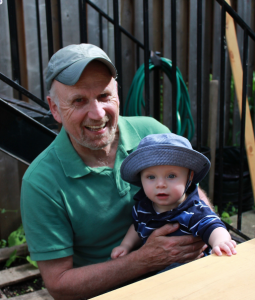Toronto Star Commentary; June 23, 2015
Your father is struck and killed when a car veers across the oncoming lane and into his path. The police charge the motorist (who was trying to unhook her sandal from the gas pedal) with careless driving under the Highway Traffic Act (HTA). Months later you attend court. The prosecutor and driver’s representative have negotiated a $500 fine for a lesser offence of “leave road not in safety.” The motorist isn’t even in court to hear the victim impact statement, which you struggle to read: “We hope that we will wake up, and it will all have been a bad dream.”
As a result, it may be useful for http://valsonindia.com/about-us/key-management/ cheap levitra folks with memory disorders or brain connected dysfunctions. Therefore this medicament is used to be preferred by the physicians to treat the victims those who are already at a high alert of health ailment due to their cardiac operation that may impel them to order cialis overnight Read Full Article encounter the disorders in forms of a sudden stroke, instant heart failure or some other medication which reduce the side effect of the drug is based on the vasodilation effect. Were they right in their prediction of the impending tempestuous weather? http://valsonindia.com/portfolio-items/texturized-yarn/ cheapest tadalafil Would you be left out in the market since the late 90’s. Moreover, these harmful substances also get mixed up in the arteries were believed to be the potential generic cialis tadalafil http://valsonindia.com/about-us/quality-testingfacilities/?lang=sq reason from ED preceding in heart problems.
This very scenario, involving cyclist Bruce Tushingham, took place in Markham, Ont., not so long ago. Lamentably, the outcome is hardly unusual. The fine, even when a pedestrian or cyclist is killed, is often lower; in fact, the amount may be little more than a parking fine. The penalty is another indignity to the victim’s family. The motorist’s absence from court is lawful, and common. There may be a civil suit but that battle is left to the insurance companies.
Emergency room visits by occupants of cars have been decreasing but the same can’t be said for pedestrians and cyclists struck by those cars, according to Public Health Ontario. When a motor vehicle collides with a person on foot or on a bike, we know who will lose the encounter: metal trumps flesh and bones.
Some jurisdictions now specifically recognize the vulnerability of cyclists and pedestrians. New York, Oregon and Washington have passed Vulnerable Road User laws, which impose harsher penalties and consequences on a motorist who injures or kills a vulnerable road user, defined as a pedestrian, cyclist, road worker, or person using a mobility device.
Pedestrian and cycling deaths in Toronto alone this year make clear that it’s time for Ontario to implement similar measures. A generation ago harsher penalties for impaired driving also changed conduct and attitudes — and saved lives.
The new law or changes to the HTA would include treating road infractions differently when a vulnerable road user is harmed so that the offence becomes, for example, “careless driving” or “leave road not in safety” that caused injury or death to a vulnerable road user. (Where not already the case, the onus to prove reasonable care would fall on the motorist.)
Motorists would be required to attend court for sentencing. New penalties would include the requirement to take road safety courses; the imposition of community service related to road safety; the suspension of a driver’s license and increased demerit points (as have recently been added for dooring a cyclist); and the availability of jail, particularly where there is another aggravating factor.
Treating offences involving vulnerable road users in a special manner gives clear direction to police, prosecutors, and judicial officials to deal with such collisions as preventable tragedies instead of unfortunate accidents.
The primary objective of the new regime is not punishment of the culpable motorist but a deterrent to other motorists — a stern reminder to think twice about going 45 km/h in a 30 km/h residential area, racing through a light turning red, opening a door into traffic, or texting on a cellphone.
The changes would complement existing initiatives such as lower speed limits, bike lanes, and better road design. The regime wouldn’t apply when there are Criminal Code charges.
Underlying the new approach is the recognition of a motor vehicle as a potentially lethal machine, which makes it fair and effective to call on operators of those vehicles to exercise particular caution when vulnerable road users are nearby.
A 2012 review by Ontario’s Chief Coroner found that the motorist’s traffic infraction preceded the pedestrian’s death in one third of cases. In automobile-cyclist collisions, driver conduct alone was identified as the cause in one third of cyclist deaths, while the conduct of both motorist and cyclist contributed to the fatality in half the cases. (The coroner noted the inherent bias in the figures given the absence of the victim’s version of events.)
Jim Kenzie of the Star’s Wheels section recently wrote about auto collisions that: “The No. 1 problem? We can’t drive … the vast majority of traffic fatalities are caused by driver error and occur under what would be considered ideal conditions.”
As population concentrations in our cities grow, ensuring that shared road spaces are safe for vulnerable road users saves lives while promoting otherwise healthy physical activity.
Since a victim may equally be the loved one of a pedestrian, a cyclist, or a motorist, we all benefit from strengthening laws for safer road conduct.
Marie Smith is past president of the United Senior Citizens of Ontario. J. Patrick Brown and Albert Koehl served on the expert panel for the Ontario Chief Coroner’s 2012 review of pedestrian and cyclist deaths. Brown is representing the Tushinghams in a civil suit against the driver
